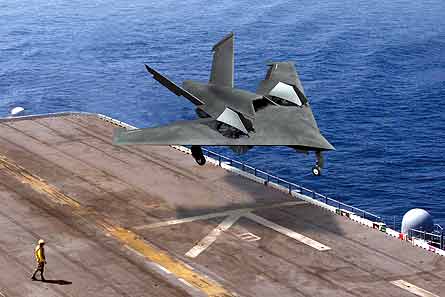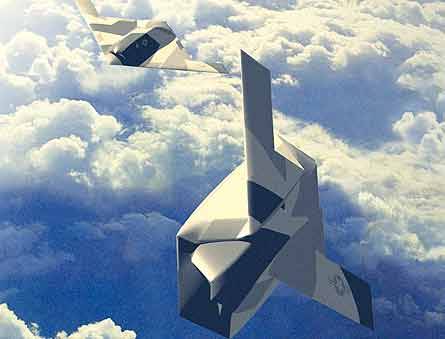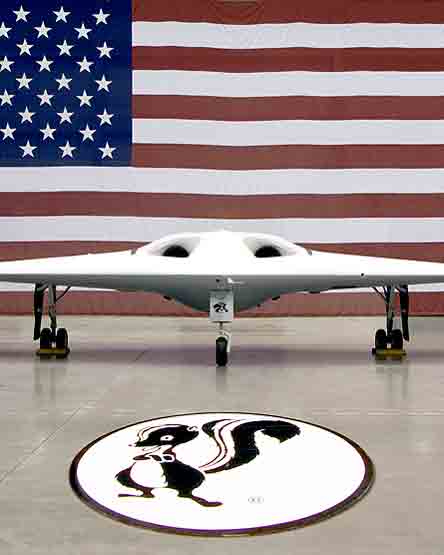After a slow start, Lockheed Martin is taking on the unmanned systems market with a vengeance and preparing a raft of products for a variety of applications
Stung by criticism of its slow penetration of the unmanned systems market, Lockheed Martin has taken the wraps off a slew of internal projects and product developments in the air, land and sea environment. These include studies of an unmanned version of the F-35 Joint Strike Fighter plans for a vertical take-off and landing (VTOL) unmanned air vehicle demonstrator and the development of new small UAVs.
"We stayed focused on winning the F-35, and did not participate in the early stages of unmanned aircraft development," says Frank Mauro, deputy director, unmanned aeronautical systems, for Lockheed's Advanced Development Programs organisation, better known as the Skunk Works.
In particular, Lockheed did not participate in the US Air Force/Navy Joint Unmanned Combat Air Systems (J-UCAS) technology demonstration. Although the J-UCAS programme was terminated earlier this year, the technology is now feeding into USAF long-range strike and USN carrier-based strike plans.
After winning the Joint Strike Fighter (JSF) competition in 2001, Lockheed's aeronautics sector began investing 30-40% of its new business funds in unmanned aerial systems. "There is a bit of playing catch-up, and some leapfrogging of where unmanned systems are today," says Mauro.
|
|---|
| The Polecat high-altitude, long-endurance UAV was built and flown in secret |
"We had to compensate for not participating in J-UCAS, and find a way to get the recognition that we are in the unmanned systems business," says Mauro. To that end, the Skunk Works built and flew its P-175 Polecat high-altitude, long-endurance UAV (Flight International, 18-24 July). "Look at J-UCAS - nothing is flying. We have something flying," he says.
The Skunk Works is spending company money to make up for a reduction in research and development funding by the US Department of Defense, and is investing in high-end UAVs, says Richard O'Lear, vice-president, unmanned aerial systems. The investment is needed, Mauro adds, because the DoD is demanding that contractors get their technology to a readiness level of 6, which requires flight testing.
Purposeful Polecat
Designed and flown within 18 months, at a cost of $27 million, the company-funded Polecat was intended to demonstrate technology to cut the cost of manufacturing UAVs by 50%. This includes use of LTM45 low-temperature composite materials, which can be cured in-situ at 65-80°C (149-176°F), avoiding the need for autoclaves. "We built the oven around the soft tooling," says Mauro.
Late to the game, Lockheed is looking towards the next generation of unmanned aircraft. "Most of today's UAVs were conceived in the 1990s. What happens after the [Northrop Grumman} Global Hawk and [General Atomics] Predator?" asks Mauro. Skunk Works projects include morphing hunter-killer, hypersonic global-strike and submarine-launched and -recovered UAVs.
Lockheed is looking for its next company-funded demonstrator, to follow the Polecat flown early in 2005 and the P-791 cargo hybrid airship flown earlier this year. One candidate is the Various VTOL UAV concept, which uses lift-fan technology from the JSF. Designed for shipborne operation, the Various has lift fans in the wing and a ducted fan in the fuselage.
Mauro says the 2,700-3,600kg (6,000-8,000lb) gross-weight Various is aimed at the US Marine Corps' VTUAV requirement for a VTOL tactical UAV, for which the Bell Eagle Eye tiltrotor is another candidate. "It's a next-generation Fire Scout," he says, referring to the MQ-8 unmanned helicopter under development by Northrop for the US Army and Navy.
 |
|---|
| Various VTOL UAV would utilise clutchless lift fan technology |
Windtunnel testing of a Various model is planned for early next year, and the VTOL UAV is a candidate for the Skunk Works' next company demonstrator. "We like to do a demonstrator every two years," says Mauro. "The last one was the cargo hybrid aircraft, which we did in nine months."
Other unmanned aircraft are being pursued by Lockheed with funding support from the US Defense Advanced Research Projects Agency (DARPA). These include a morphing-wing concept for a next-generation hunter/killer UAV combining long loiter endurance with high dash speed (Flight International, 15-21 August).
 |
|---|
| Morphing hunter-killer UAV would combine endurance and speed |
DARPA-funded flight tests of a subscale folding-wing morphing UAV are planned for early next year. "We are looking for a 4:1 dash to loiter speed ratio," says Mauro. "We will not necessarily stay with the folding wing. We are looking at other ideas, including telescoping wings."
Under DARPA's Cormorant programme, the Skunk Works is demonstrating technology for a multipurpose UAV that could be launched and recovered via the torpedo tubes of a submerged nuclear submarine. In the first phase, Lockheed proved it could seal the vehicle. The next stage involves demonstrating the UAV can crash land on water and survive, and be recovered into a submerged tube.
In tests to run from November to January, a full-scale, non-flying model of the folding-wing UAV will be dropped 15m (50ft) into the water to simulate a parachute recovery. Retrieval of the folded UAV into a tube on the ocean bottom will be tested separately. Lockheed also plans a test to ensure that the UAV's Williams turbofan can be spun up when the vehicle broaches the surface after being boosted from the tube.
Under DARPA's Falcon programme, the Skunk Works is developing a family of unpowered, rocket-boosted hypersonic test vehicles to demonstrate technology for a Mach 10 unmanned aircraft able to strike anywhere in the world within 2h. The company is also under contract to ground-test a combined-cycle propulsion system for the Falcon, using a high-Mach turbine engine and a supersonic-combustion ramjet.
Mauro says Lockheed is now in discussions with DARPA on a powered Falcon demonstrator that would be able to take off, cruise at M6 and land, using the combined-cycle powerplant. The demonstrator would be about 15m (50ft) long, compared with the full-scale, "B-52-sized" vehicle carrying a 7,250kg payload, he says.
Near-term products
While many of the Skunk Works' concepts are years from fruition, other parts of Lockheed are looking much more near term for unmanned systems opportunities. The company's Maritime Systems & Sensors business is completing development of an improved version of its Skunk Works-designed Desert Hawk small hand-launched force-protection UAV. The Desert Hawk III can be disassembled, making it backpackable, says Tom Lewis, senior manager, business development.
The company has also teamed with the University of Minnesota to develop the Sky Spirit, a "mid-tier" tactical UAV with up to 22h endurance. The twin-boom, pusher-propeller vehicle is being offered for the US Marine Corps' Tier-2 programme, which has been merged with a US Navy requirement for a ship-launched UAV, with a technology-demonstration contract now expected to be awarded early next year.
The Maritime Systems & Sensors organisation is also leading Lockheed's pursuit of the US Navy's Broad Area Maritime Surveillance (BAMS) requirement, for which it has teamed with General Atomics to offer the Mariner version of the Predator B UAV against expected competition from Northrop's Global Hawk. A draft request for proposals is expected in October.
While Lewis acknowledges Lockheed could yet decide to offer a derivative of the Polecat, the Mariner is its current offering "for BAMS as we understand it". The final proposal will depend on the US Navy's requirements. "If they ask for low observability and high altitude, we will have the choice [of offering Polecat]," he says.
Across the company, Lockheed is working on unmanned systems as diverse as high-altitude airships (Flight International, 15-21 August) and remote mine-hunting vehicles, but is focusing the resources available across its business sectors on systems rather than platforms, says O'Lear.
"There has been a transition from unmanned vehicles to unmanned systems," he says, with systems including not only platform and payload, but communications and control, tasking and processing and training and maintenance. "We are still in a platform centric world, but the shift is to unmanned and systems of systems."
More UAV stories at FlightGlobal.com/UAV
Source: Flight International
























